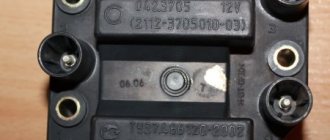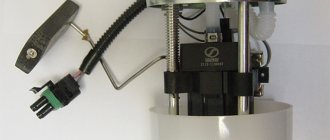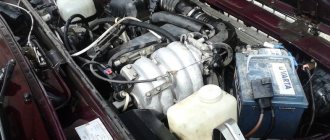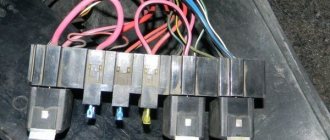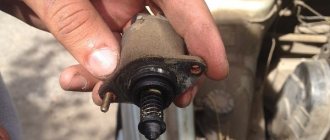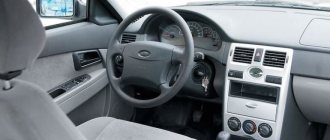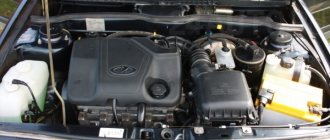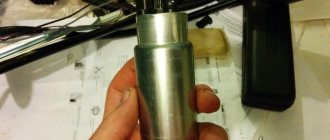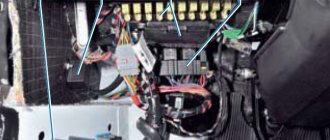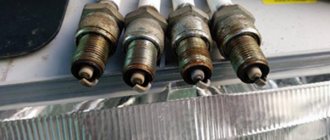Lada 2115 Evil TaziK™ › Logbook › for yourself Diagnostics of the fuel pump and injectors VAZ - 2115
The April issue of the magazine “Behind the Wheel” showed ways to check the electrical circuit of the fuel pump on a VAZ-2110...2115.
Let's assume that it is working properly: the pump hums as usual. But does this mean that gasoline is supplied to the injectors normally? No! This is where problems may arise. Let's start with the simplest. Remove the protective cap of the fitting (photo 1),
put a rag underneath so as not to spray the engine compartment with gasoline, and use the tip of a thin slotted screwdriver to press the spool of the fitting. A thin, weak stream of gasoline indicates low pressure in the fuel rail - you will have to look for the reason. If gasoline sprays with good pressure, there is hope that the pressure is close to normal (2.8–3.2 bar), all that remains is to measure it with a pressure gauge. Service specialists do this using fuel pressure gauges with adapters. We will use a simple one, from a tire pump. It is only important that the measurement limit is at least four bar. You will also need a piece of gas-resistant hose 150 mm long with an internal diameter of 10–12 mm, and two clamps for it. Using the wheel valve cap, unscrew the spool valve from the fuel rail fitting (the pressure has already been released) (photo 2).
We put the pressure gauge hose on the fitting and tighten it with a clamp. We turn on the ignition without starting the engine: after two seconds, the fuel pressure in the rail should rise to 2.8–3.2 bar and stabilize at this level (photo 3).
If it is significantly lower (about 1 bar) and remains this way for a long time, you need to check the supply line 4 (see figure) - most likely, it is clogged. There are two problem areas here: fuel filter 5 and fuel pump mesh 2. First, let's check the filter. It is located under the underbody near the gas tank (photo 4).
If it's ok, let's look at the pump grid. We remove the fuel pump from the tank, remove the screen and wash it. Before installing the fuel pump, it is very useful to check the tightness and reliability of the connection of its tube (arrow in photo 5)
to the fuel line. You will, of course, ask what to do if the supply line is clear, the pump is humming, and the pressure is low. Change the pump! It's worn out. And it also happens that the pump is working, but there is no pressure in the ramp at all! This happens in winter if there is a lot of water at the bottom of the gas tank. If it freezes on the pump grid, it will interrupt the flow of gasoline into it. What to do? Under no circumstances should you light a fire under the gas tank or heat it with a blowtorch or other source of fire. It would be better to remove the fuel pump and clear it of ice. Another option is for those in no hurry: roll the car into a warm room and wait... By the way, in this case it makes sense to drain the water from the gas tank at the same time. It's a troublesome task, but rewarding. But now we are convinced that the pressure in the ramp is normal. Does gasoline enter the engine cylinders? This is not a fact! The injectors may become clogged, the fuel supply may decrease, or even stop completely. But sometimes the injectors do not receive a control signal, although they themselves are working. We begin the control by inspecting the spark plugs. Wet means fuel is supplied. Dry? Then we’ll check the signal at the injector harness connector with a probe (photo 6).
Yes, are the spark plugs dry? You will have to unscrew the screws securing the ramp and lift it under the intake manifold so that the injector nozzles become visible. Turn on the ignition and turn the engine crankshaft with the starter. Can't see the streams of gasoline? This means that the injectors will have to be removed and, most likely, replaced with new ones. True, almost every serious service will offer you to wash them. Take an interest in prices: if a new set of injectors is slightly more expensive than flushing, replacement should be preferred. After all, old injectors also have age-related diseases.
Fuel pump weight
The contact system is normal, but the gasoline level sensor is acting up. Let's see what happens to the mass of the fuel pump. It may be poorly secured. In this case, the fuel pump will not be able to pump anything.
The mass of the fuel pump itself is attached to it in the area of the handbrake, under the dashboard. When you pull the handbrake, you can touch the ground contacts of the fuel pump, and the connection may be lost.
It is not difficult to tighten the mass of the fuel pump, it is difficult to reach it. Namely: get the grounding contact of the ground conducting the lost connection. We remove the plastic under the handbrake and the floor covering of the car, respectively; We clean the contact and firmly attach the mass to the fuel pump.
In the same place as the fixed mass of the fuel pump, under the dashboard, its relay is located.
Ideally, when ignited, the relay creates the required pressure in the system in a couple of moments and turns off. If this does not happen, the pressure is normal, but the process does not proceed, we completely lift the front facing panel that covers the contacts of the music and air conditioner and look from the passenger side: there are three switches, the lowest one is from the fuel pump. When you turn the key, the relay makes a characteristic click and works. If there is no click, the relay or its contacts are closed.
Models of fuel pumps for VAZ 2114/2115 cars
VAZ 2114/2115 cars are equipped with 1.5 cm 3 and 1.6 cm 3 gasoline engines with a distributed injection system. A submersible electric fuel pump is used to supply fuel. It is part of the fuel module installed at the top of the gas tank (under the rear seat). In addition to the pump, the module includes a fuel accumulator (cup), a coarse filter and a fuel level sensor with a float.
To supply fuel in VAZ 2114/2115 cars, a submersible electric fuel pump is used
The VAZ 2114/2115 fuel pump is a conventional DC electric motor in a sealed housing with a one-way valve at the outlet. An impeller of a special shape is located on the electric motor shaft. Its rotation ensures the fuel supply.
The fuel module includes a fuel pump, a fuel accumulator, a coarse filter and a fuel level sensor
The fuel pump is powered from the vehicle's on-board network. The electrical circuit of the pump, protected by a fuse, is closed using a separate relay.
Electric fuel pumps for VAZ cars are produced by both domestic (Utes, SAAZ, Pekar) and foreign companies. The latest modifications of the VAZ 2114/2115 are equipped with BOSH pumps, which are distinguished by their high reliability, long service life and relatively low price.
Design of the electric fuel pump VAZ 2114/2115
Catalog numbers of standard fuel pumps for VAZ 2114/2115:
- 2112–1139009–12 - for engines with a volume of 1.5 cm 3;
- 2112–1139009–01 - for engines with a volume of 1.6 cm 3;
- 580453453 (BOSH) - for engines with a volume of 1.5 and 1.6 cm 3.
These models differ in operating pressure. The former are capable of creating a pressure of 2.8–3.2 kPa in the fuel system, the latter - 3.7–3.9 kPa. BOSH fuel pumps are rated at 3.5 kPa.
Fuel pump pinout
The pinout of the VAZ 2114 fuel pump chip includes contacts for power supply to the electric motor, a fuel level meter contact, and a critical residue alarm contact.
Thus, the pump block chip includes four contacts:
- Remaining indicator:
- Weight;
- Pump power;
- Fuel level.
The power connector located on the block has a pin part - “male”, respectively, the mating part is “female”. It should be borne in mind that the pump unit is not connected to the on-board network directly, but through an adapter harness, one of the terminals of which is connected to the block and the other to the on-board network.
The following wire colors are used in this harness:
- Black and white – mass;
- Gray – supply voltage;
- Pink – level indicator;
- Blue and red – reserve balance.
Symptoms of a problem
A malfunction of the fuel pump of VAZ 2114/2115 cars can be diagnosed by the following symptoms:
- when the ignition is turned on, there is no sound of the pump running;
- the engine does not start or starts with difficulty;
- the power unit is unstable at idle, the speed “floats”;
- “dips” appeared during acceleration;
- the motor has lost power.
The same signs also appear when other elements of the fuel system malfunction.
Before you begin diagnosing or replacing the fuel pump, you should make sure that:
- the fine fuel filter is not clogged (it is changed every 7 thousand kilometers);
- the injectors and fuel pressure regulator are operating normally;
- The sensors for mass air flow, throttle position, and oxygen quantity are working properly.
If the detected malfunction is accompanied by the lighting of the “CHECK” lamp on the dashboard, you should set the error code and decipher it.
Signs of breakdown
There are several situations in which the pump or its components can be at fault. This will definitely have to be checked. Otherwise, you can spend a lot of money buying and installing a new fuel pump, but in the end it turns out that the problem is completely different.
- The engine will not start. This is not a clear sign of problems with the pump, but still. Therefore, first check the condition of the spark plugs, the presence of a spark, and the absence of traces of oil on them. Also check the electronic control unit.
- Pressure inside the fuel system. If the pump is operating normally, it will create a pressure of 3.2 bar. Depending on the type of engine in your VAZ 2114, the characteristics may differ slightly: For a 1.5-liter engine, the optimal values are 285-325 kPa;
- For a 1.6-liter engine, these characteristics in optimal operating mode will range from 375 to 390 kPa.
New and old coarse filter
We recommend: Changing the parking brake cable on a VAZ-2110 with your own hands
Many people purchase the entire fuel module assembly at once, which includes a filter, sensor, float, intake chamber and the pump itself. Such a purchase will cost approximately 3,000 rubles. It is much more profitable and practical to buy a separate pump, which costs up to 1000 rubles. This is due to the fact that when the pump fails, the remaining elements almost always remain intact and are fully suitable for further use.
Diagnostics
A malfunction of the VAZ 2114/2115 fuel pump can be caused by:
- malfunctions in the device’s power supply circuit;
- failure of starting and protection elements (relay and fuse);
- wear of electric motor parts.
Checking the electrical circuit
At the beginning of the diagnosis, you should check the electrical circuit of the fuel pump. To do this you will need:
- car tester (multimeter);
- crosshead screwdriver;
- two pieces of wire about 2 m long.
PRINCIPLE OF OPERATION OF THE SYSTEM
The fuel system of the VAZ 2114, in comparison with foreign cars, is made quite simply, thanks to which a high level of its reliability and endurance has been achieved. The 2114 has an injector for injecting gasoline into the combustion chambers. The presence of an injector provides for a complex fuel dosing system, for which the ECU controller (electronic control unit) is responsible.
The VAZ 2114 fuel pump is driven electronically. The injection moment itself is calculated thanks to sensors that determine the location of the car’s crankshaft. When the fuel pump is turned on, the fuel is supplied through the transport system to the filters, where it is cleaned of impurities, and after the filters - to the fuel rail.
The fuel rail is the part of the intake manifold in which gasoline and gas are mixed in a ratio of 1 to 15 (an increase or decrease in the amount of gas can be adjusted manually, but the optimal gasoline consumption is observed precisely at the above ratio). Next, the mixture is supplied to the injectors, after which it enters the combustion chambers.
Fuse
Fuse 15 A
One of the final stages of checking a malfunctioning fuel pump is its fuse. Like the relay, the fuse can be seen from the inside. Or you can climb in from the outside, through the hood. Under the hood, closer to the windshield, there will be a dark box, right on the electronic control unit. You need to open it and find the topmost fuse with a current of 15 A and the English inscription fuel pump. We take it out and look at the insides: the contact is not damaged - the fuse is alive. The contact is damaged (blown) - you need to install a new fuse. As with the price of the relay issue, buying and replacing a fuse will not be a big waste of money and time.
Not every master's hands grow from the right place. For this reason. The reason that the fuel pump does not pump can be simple stupid shortcomings of simple tuning.
For example, the alarm was installed in such a way that all the contacts were mixed up, and power simply does not go to the fuel pump. Not because the alarm should not be on the car, or the wiring system is acting up, it’s just that the person who installed it didn’t have enough brains and practice. Check all connections carefully if you decide to add some style to your little one.
Or anti-theft. The button is placed in such a way that it interrupts the integrity of the fuel pump ground contact system, and almost always fails. By the way, if you have such a lotion, I don’t think it will be very effective in the absence of a signal. And if there is a signaling system, then anti-theft is not needed at all.
In any case, remember: in any situation where a VAZ breaks down, the point is not that it is a VAZ, and it was made poorly. It’s just that the Russian auto industry is a little more delicate than the foreign one, it requires a little more attention and your ingenuity.
WHAT GASOLINE TO POUR IN THE VAZ-2114?
This topic has become overgrown with various conjectures and speculations, but we will try to put everything in its place.
The technical data sheet of the fourteenth indicates that the car engine requires AI-95 gasoline, and there is no reason not to trust the manufacturer’s recommendations.
Another thing is that many car owners, over their long driving experience, have accumulated rational doubts about the existence of any serious differences between 95 and 92 gasoline. Adding fuel to the fire was the recent statement by the chief engineer of the Moscow oil refinery, A. A. Abrosimov, that we do not make 95-grade gasoline in our country, and everything that is sold under its guise is either 92-grade or unknown fuel brought from somewhere.
As evidenced by reviews from VAZ 2114 owners who use exclusively 92-octane gasoline, there were no problems with the car during its service life due to fuel, and they see no point in using a more expensive analogue. However, the final decision about what to pour into the fourteenth is yours.
COMPONENTS OF THE FUEL SYSTEM
The VAZ 2114 fuel system consists of the following main elements:
- Gas tank;
- Fuel pump;
- Gasoline filtration devices;
- Pipeline system;
- Fuel rail;
- Injectors;
- Waste disposal unit.
Fuel system diagram
Let's analyze each component separately.
GAS TANK
The VAZ 2114 gas tank is a container made of two equal metal parts. A neck is removed from the tank into which gasoline is poured. The neck is connected to the tank via a rubber pipe and clamps.
FUEL PUMP
The fuel pump is located directly in the tank. It has a fuel level sensor, which transmits information about the current amount of gasoline to the ECU. The gasoline pump is connected to a line through which gasoline is transported to the fuel rail. The fuel pump itself consists of several parts - coarse filters, wiring and an electric motor, which pumps fuel. As evidenced by reviews from owners of fourteenth cars, fuel pumps from the German company BOSCH have proven themselves to be the best.
FILTRATION DEVICE
The VAZ 2114 fuel injection system very much depends on the quality of the filter devices used. A bad filter will significantly reduce both the efficiency and the longevity of the entire system.
On the fourteenth, non-separable filters with a working element made of paper are installed. Such filters clog quite quickly, and they need to be changed at least once every 10-15 thousand kilometers.
FUEL RAIL
The fuel rail is located on the intake manifold housing. Its design consists of two parts, separated by a spring-loaded diaphragm. The first is the fuel one, in which the required level of gasoline pressure is set, the second is the air one, air is pumped into it, due to which the diaphragm compresses the fuel chamber and changes the pressure level in it.
Ramp
PIPING AND HOSES SYSTEM
To circulate gasoline from the gas tank to the injectors, the fourteenth uses steel fuel lines located on the bottom of the car. The VAZ 2114 fuel supply system also provides for a return pipeline through which excess gasoline from the injectors is returned back to the gas tank.
VAZ 2114 owners are advised to carefully monitor the condition of the fuel line in order to avoid gasoline leaks. Pipes should be checked regularly for deformation and corrosion.
INJECTORS
Injectors are valves actuated by electromagnetic control. They have a sprayer, with the help of which fuel under pressure is supplied directly to the combustion chambers.
Injectors are one of the most problematic parts of the fuel supply system of the fourteenth (as well as VAZ 2115 and VAZ 2113), the service life of which directly depends on the quality of the gasoline used. If the fine filter does not fully perform its functions, the injectors will become clogged, and from time to time you will need to clean them at a service station (doing this at home is very problematic).
A critical failure of the injectors is a short circuit or break in the winding, after which it is necessary to replace the failed part.
WASTE DISPOSAL UNIT
The EURO-3 environmental safety standard, to which the VAZ 2114 complies, provides for the presence of a gasoline vapor recovery chamber, for which the fourteenth uses an adsorber with activated carbon. The adsorber is connected to a throttle assembly, from which all resulting vapors are sucked out.
Adsorber
PREVENTION OF THE FUEL SYSTEM VAZ-2114
Prevention, as a rule, comes down to regular cleaning and, if necessary, replacing the fuel pump filter and the main fuel system filter.
Also once every 25-30 thousand km. It is necessary to clean the injectors, which is performed exclusively at a service station. There are two methods for cleaning injectors, neither of which require removing them:
- Ultrasonic cleaning;
- Cleaning with a special washing liquid.
The most effective and expensive is ultrasonic cleaning, which makes it possible to bring back to life even heavily worn nozzles.
Fuse
This is the final stage of diagnosis.
So, under the hood, near the windshield, there is a box. You need to open it and find the top fuse. Its current strength is 15 A. It is also written on it that it is for the fuel rail. If the fuse contact is intact, it means it is alive. If the contact is not OK, the fuse must be replaced.
These are the typical faults this unit has, and in the manner described above you can diagnose it.
What fuel pumps are installed on the VAZ 2114/2115
The gas pump (or fuel pump) pumps fuel from the gas tank to the engine. On models 14 and 15 of the VAZ family, the fuel pump is located in the fuel tank. The gas tank is located on the bottom of the car, in the rear. Therefore, in order to get to the fuel pump if necessary, you will need to remove the cushion from the rear seat in the cabin and find a small hatch hidden underneath.
The device is “hidden” under the rear seats, under an inconspicuous hatch in the car body
On cars of the Samara VAZ family (that is, on “fourteeners” and “tags”), “native” factory fuel pumps of the “Saratov” brand are installed. Their performance is average, but in terms of tightness they can let the driver down at any time. However, their main advantage is their low cost.
Each owner of a VAZ-2114/2115 can easily replace an unwanted fuel pump with a better one. For example, the domestic “DAAZ” or the time-tested “Pekar”.
The production of gasoline pumps is located in Dmitrovgrad
Foreign analogues: QH (England) and OTA (Italy) also fit perfectly into the fuel system of domestic cars, however, their cost is almost three times higher than the price for a Saratov fuel pump. However, unlike domestically produced pumps, QH and OTA products are equipped with only one membrane, but a very thick one. Therefore, when using foreign expensive gasoline pumps, the possibility of fuel getting into the oil is practically excluded.
Pekarov production was opened in St. Petersburg
Table: comparative characteristics of fuel pumps for VAZ 2114/2115
| Fuel pump test results | |||||
| Characteristic | "Baker" | DAAZ | Saratovsky | QH | OTA |
| Zero supply pressure (at a crankshaft speed of 2000 rpm), kgf/cm2 | 0,26 | 0,28 | 0,26 | 0,3 | 0,36 |
| Capacity for free drainage (at a crankshaft speed of 2000 rpm), l/h | 80 | 76 | 73 | 92 | 74 |
| Suction period at crankshaft speed 200 rpm, s | 4 | 13 | 12 | 9 | 6 |
| Valve tightness at a pressure of 0.3 kgf/cm2 (fuel leakage within 10 minutes), cm3 | 8 | 12 | 20 | 8 | 8 |
| Place | 3 | 4 | 5 | 1–2 | 1–2 |
How to check the performance of the fuel pump
Often, for those problems for which the car owner blames the fuel pump, other elements of the fuel system are to blame. To establish whether a fuel pump has failed, you will need to know the reasons why it might break.
Causes of fuel pump malfunctions
Most often, the device may fail while the vehicle is moving. The gas pump may simply refuse to pump fuel from the tank to the engine, or a leak may form, causing the device to malfunction. If the power supply is interrupted, the pump stops working completely.
The main causes of fuel pump malfunctions include the following:
lack of tightness in the pump itself (leakage);
damage to membrane surfaces;
the resource of the pump motor has been used up;
wiring or relay problems;
dirt and debris in the fuel tank, which, along with gasoline, enter the pump.
As you can see, there can be many reasons for a fuel pump to fail.
Dirt deposits on the filter mesh are a common cause of fuel pump malfunctions.
Symptoms of a problem
There are only four main signs by which you can diagnose malfunctions in the fuel pump without special tools:
The car simply won't start. Of course, the engine may not function for a number of other reasons, however, first of all, you will need to check the functionality of the fuel pump itself.
After the car starts, the characteristic buzzing of the fuel pump is inaudible. The whirring noise should be clearly audible in the rear of the cabin, as the fuel pump is located under the rear seats.
Recently, interruptions in the operation of the power unit have begun to be observed: the engine does not start the first time, while driving you can hear the engine straining.
The car starts to jerk when driving at low speed.
Malfunctions
The main signs that the fuel pump is not pumping are as follows:
- the power plant does not work;
- when the ignition is turned on, the noise of the pump is not heard;
- if the engine is running, then interruptions occur periodically;
- the car moves jerkily.
Thus, checking whether it works is quite simple: turn on the ignition and listen. A characteristic sound will indicate that it is working properly. You need to listen in the rear seat area, because that is where the gas tank is located.
The most common breakdowns:
- fuse blown;
- relay failure;
- incorrect or unreliable ground connection;
- contamination of terminals;
- failure of the electric drive.
It should be admitted, however, that the latter happens very rarely. Due to the fact that this unit is well cooled, it is not afraid of overheating.
Most often, the centrifugal vane hydraulic supercharger, located in the pump itself, fails. The reason for this is usually the low quality of the fuel and its high contamination with foreign substances. In this case, they act as an abrasive and wear away the working surfaces, as a result of which the tightness of the seal is disrupted and, accordingly, the efficiency decreases.
The more worn the pump is, the louder it runs and the worse it pumps. If necessary, the problem can be eliminated by replacing the entire assembly, which includes both the electric motor and the pump itself.
If the fuse is blown, replace it with a new one.
The relay fails for the following reasons:
- fatigue of materials;
- incorrect installation;
- poor workmanship.
Unreliable fastening of the mass leads to regular loss of contact. An incorrect connection will prevent the pump from starting at all.
Repair of fuel pump VAZ 2114/2115
When repairing the fuel pump, we will proceed from the fact that we have already removed the fuel pump from the tank. How to properly dismantle the device will be written below, but we will dwell in more detail on the description of the progress of the repair work:
You will need to remove the protective cup from the module - to do this, you will have to pry the cup latches with a screwdriver, and the fuel pump will come out freely.
We unscrew the two screws from the fuel pump housing that secure the fuel level sensor, then disconnect the cable of wires coming from the sensor and put it aside.
Next, you will need to disconnect the filter mesh from the pump using a flat-head screwdriver.
To complete the disassembly, you need to remove the housing itself from the device - there is a cotter pin on the surface that needs to be pulled out.
You will need to carefully examine all parts of the device for cracks, tears and deformations. As a rule, most often some specific parts of the fuel pump fail, which are much easier and cheaper to replace than to buy a new device. Replacing membranes, rubber bushings or filters is not particularly difficult: use a screwdriver to pry off the old product and pull the new one in its place. The fuel pump mesh, float or fuel level sensor can also be easily mounted with a regular screwdriver.
The unit is reassembled in the reverse order.
Video: how to repair a fuel pump on a VAZ 2115 with your own hands
Selecting and replacing the fuel pump
Russian car owners prefer BOSH fuel pumps. You should only buy a new pump in specialized stores. The original product must be packaged in thick plastic film filled with special preservative oil. At the same time, a branded BOSH pump cannot cost less than 2 thousand rubles.
Video: how to distinguish an original from a fake
To replace the electric fuel pump on a VAZ 2114/2115 you will need:
- screwdriver with Phillips bit;
- thin slotted screwdriver;
- key or head 7;
- key to 10;
- key to 17.
What to do if the fuel pump does not work
Before deciding anything regarding the repair or replacement of this device, it is worth remembering that the function of the gas pump is to create a certain pressure in the fuel system of the car. Accordingly, the first step is to measure the fuel pressure, quite possibly in order to accurately diagnose the failure of the fuel pump.
Measuring pressure in the fuel system
Normal atmospheric parameters in the VAZ-2114/2115 fuel system are as follows:
at idle - 2.5;
after turning on the ignition - from 3;
without pressure regulator tube - 3.3;
with pinched drain - 7;
after pressing the gas pedal - from 3 to 4.5.
You will need to measure the pressure in five operating states of the fuel system at once in order to obtain accurate data. There is a pressure fitting under the hood of the car; you will need to unscrew the cap from it and attach a pressure gauge with a hose. By turning on the ignition, holding the drain, pressing the gas, it is necessary to take all five pressure measurements.
Using a pressure gauge, you can measure the fuel pressure and, based on this indicator, look for a malfunction
Wiring check
If the pressure readings are almost identical to normal, you will need to check the wiring for a short circuit. It is quite possible that the fuel pump itself is in working order, only the contacts that go to it have been damaged.
It is necessary to check the fuel pump wiring for short circuits.
You need to know that the wiring system, which goes directly to the fuel pump itself, has three wires: positive, negative and an indicator of the fuel level in the tank. You will need to take a regular light bulb with a power of no more than 12 V and attach its wires to the “+” and “-” contacts on the external connector of the pump. After starting the engine, if the lamp blinks, then there is contact.
If there is a flaw in the wire circuit, the light bulb will not light up. The internal contacts of the fuel pump are checked as follows:
one by one, the light bulb wiring is connected to the “+” and “-” connectors of the fuel pump, then to its ground and relay;
if the lamp blinks when connected to the negative contact, then the fuel pump contact is considered not working, and if it does not blink, then the “+” contact is not working.
After this, you will need to first check the relay and fuse: if they are normal, then the wiring is damaged somewhere between the pump and the relay.
Popular breakdowns
Problems with the fuel pump can occur for several reasons. Therefore, your first priority is to determine the source of the problem. These may be:
If one of these elements fails, it can stop the normal functionality of the entire module.
Let us consider the situations with each of the specified elements of the fuel module in more detail.
Pressure
What exactly is a fuel pump? This is an element of the fuel system that allows fuel to pass through due to pressure. Therefore, if you take pressure measurements, you can get answers to many questions.
Let's give an example of normal pressure readings when checking in certain modes.
Check mode
Normal indicator
At idle
Without pressure regulator tube
When the drain is pinched
When you press the gas pedal
We recommend measuring with a small range of atmospheres on a pressure gauge (up to 7 atm). This will reduce errors to a minimum. Having a pressure gauge at hand will allow you to significantly save on professional diagnostics.
Contacts
The fuel pump includes three wiring:
- Plus (positive);
- Minus (negative);
- Fuel level indicator.
So, failure of the pump may occur due to a simple violation of the integrity of the wires. So if the pressure check shows normal, then we definitely examine the condition of the wiring.
To check, you will need a 12V lamp, which is attached to the external connectors of the pump with positive and negative contacts. Turn the ignition key. If the lamp blinks, contact is present. In this case, you will have to check the condition of the internal contacts.
Replacing the fuel pump on a VAZ 2114/2115
Before you begin work, you should relieve the fuel pressure in the system. Even when the pump is not working, the pressure can remain very high, which will lead to the pressure of a stream of gasoline during dismantling work.
To reduce the pressure in the fuel system of a car, it is enough to let it stand on level ground for three hours. The fuel pressure in the hoses and pipes will noticeably decrease, and replacing the device will take place without any difficulties.
Not in all cases it is necessary to replace the fuel pump with a new one; sometimes it is enough to simply repair it
Preparing tools
To make all stages of the work easier, you will need to prepare several tools. As a rule, most car owners have all of them:
open-end wrench 17;
extension for key.
How to remove a faulty fuel pump in a VAZ 2114/2115
The procedure for dismantling the fuel pump determines the following stages of work:
Open the hood and disconnect the negative terminal from the battery.
Raise the rear seat cushion inside the vehicle.
There is a small hatch under the seat - it is under it that the fuel pump is located.
Using a 17mm wrench you will need to unscrew all the nuts securing the hatch to the floor.
Putting the hatch cover aside, you will need to disconnect the two wire blocks. To do this, you will first need to bend the fixing element on the plug.
Next, using a 17mm wrench, you will need to unscrew the nuts on the fuel line and disconnect the fuel pipes.
After this, the fuel pump itself will become accessible. Using an extension cord and a wrench, you will need to unscrew all the fasteners that connect the pump to the metal surface of the car.
The best way to remove the fuel pump is to use a screwdriver to hook it onto the rubber ring.
Video: how to replace the fuel pump in a VAZ 2114
How to install the fuel pump back
The procedure for installing the fuel pump in the VAZ 2114/2115 is completely reverse: that is, you will first need to insert the device into the cavity under the seat, and then connect all the disconnected wires and tubes. The final stage is closing the hatch and returning the rear seat cushion to its original place.
The ability to independently diagnose a fuel pump failure, as well as quickly replace or repair the device, will be especially useful for those drivers who are accustomed to servicing their car themselves. In addition, the procedure for checking the fuel pump and its repair cannot be considered particularly complex work, so even an inexperienced owner will be able to get the fuel pump into working condition without contacting a service station.
Removing, installing and replacing the fuel pump
The first thing to keep in mind is that all work on the car’s fuel system must be carried out with the negative terminal of the battery disconnected. It would also be a good idea to do this with an empty fuel tank, especially since with the fuel module removed it becomes possible to clean the bottom of the gas tank from sediment.
The second thing it is advisable to do is to remove the pressure inside the fuel lines so as not to get a stream of gasoline in your face or into the interior of the car. This can be done using a measuring nipple on the fuel rail and a thin screwdriver.
To work you should prepare:
- curved and flat screwdrivers
- key for 17
- head for 7
- rags
Sequence of work
- Raise the rear sofa.
- We unscrew the two screws that hold the cover that blocks access to the fuel module, and disconnect the electrical connector from it.
- Using a 17mm wrench, unscrew the two fuel lines connected to the pump, being careful not to lose the O-rings, and move them to the sides.
- Newer models have clips on the pump; to remove them, press them and pull the tubes towards you.
- Using a 10mm socket, unscrew the 8 nuts that secure the pressure plate in a circle, holding the entire fuel module.
- Carefully remove it through the hole in the gas tank, having first released the fuel level sensor float.
If there is a new assembled module in stock, install it in the reverse order. If it is necessary to replace individual components: the fuel pump itself, the level sensor or the primary filter mesh, we do this by disassembling the fuel module housing and removing the corresponding parts.
This procedure is unlikely to cause any difficulties - everything is quite obvious.
For a new type of fuel pump, you need a 10mm socket and a ratchet, similarly unscrew the ring in a circle and press out the fuel line clamps.
We recommend: How to drain the coolant and flush the engine cooling system on a VAZ 2114

